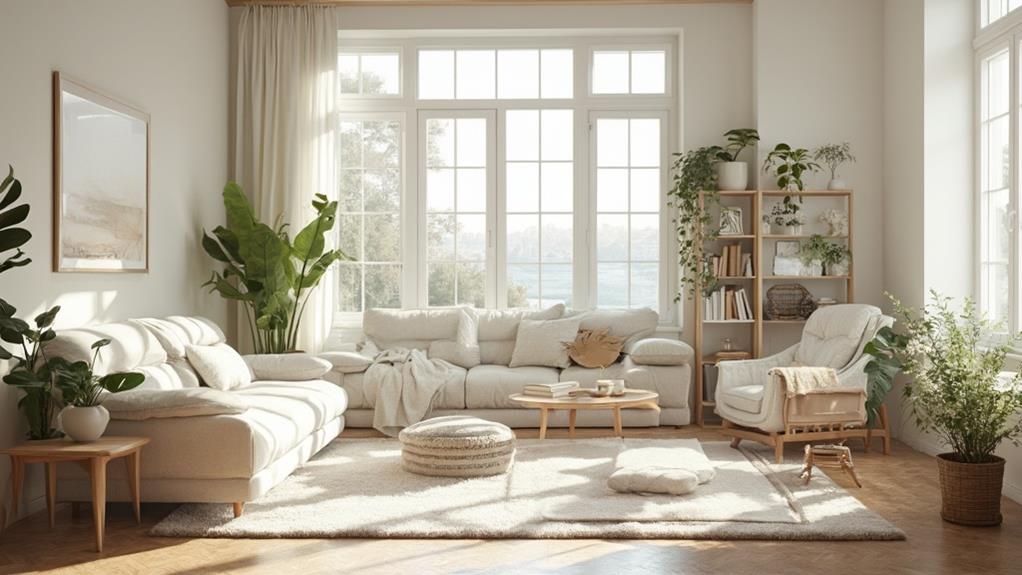The psychology of space in home design significantly impacts mental well-being. Thoughtful renovations can enhance mood, productivity, and quality of life. Color psychology influences atmosphere, while spatial flow fosters mental clarity. Maximizing natural light boosts mood and regulates circadian rhythms. Decluttering reduces stress and supports emotional well-being. Incorporating biophilic design principles connects occupants with nature, promoting overall health. Personalization creates an emotional bond with living spaces. By considering these psychological aspects during renovations, homeowners can create environments that nurture mental health and happiness. Exploring these concepts further reveals the profound impact of mindful design on well-being.
Color Psychology in Home Design
The palette of your home speaks volumes about its atmosphere and your state of mind. Color psychology plays a crucial role in home design, influencing mood, energy levels, and overall well-being.
Warm hues like reds, oranges, and yellows can create a vibrant, energizing environment, ideal for social spaces like living rooms or kitchens. These colors stimulate conversation and appetite, making them perfect for areas where people gather.
On the other hand, cool tones such as blues, greens, and purples promote relaxation and tranquility. These colors are well-suited for bedrooms and bathrooms, where calmness is essential. Neutral shades like beige, gray, and white offer versatility and can create a sense of spaciousness. They serve as excellent backdrops for accent colors or statement pieces.
When selecting colors for your home, consider the function of each room and the emotions you want to evoke. Light colors can make small spaces appear larger, while dark hues add depth and coziness to larger rooms. Remember that personal preferences and cultural associations also play a role in color perception, so choose shades that resonate with you and your lifestyle.
Spatial Flow and Mental Clarity
While color selection impacts mood, the arrangement and flow of spaces within a home significantly affect mental clarity and overall well-being. Spatial flow refers to the seamless transition between different areas of a home, creating a sense of openness and continuity. This design principle can reduce stress and promote a feeling of calm by eliminating visual clutter and physical barriers.
To enhance spatial flow, consider open floor plans that connect living areas, kitchens, and dining spaces. This layout fosters social interaction and improves natural light distribution. Utilize consistent flooring materials and color palettes throughout to create visual cohesion. Incorporate elements like sliding doors or movable partitions to provide flexibility in space usage.
Decluttering and organizing spaces are crucial for mental clarity. Implement smart storage solutions and minimize unnecessary furniture to reduce visual distractions. Create dedicated zones for specific activities, such as a quiet reading nook or a home office area, to improve focus and productivity. Pay attention to traffic patterns within the home, ensuring smooth movement between spaces. By thoughtfully designing spatial flow, homeowners can create an environment that supports mental clarity, reduces stress, and enhances overall well-being.
Natural Light and Mood Enhancement
Natural light plays a crucial role in enhancing mood and overall well-being within a home. Exposure to sunlight stimulates the production of serotonin, a neurotransmitter associated with improved mood and focus. When planning a renovation, prioritize maximizing natural light to create a more positive living environment.
Consider incorporating larger windows, skylights, or glass doors to increase the influx of sunlight. Strategically placed mirrors can reflect and amplify existing light sources, brightening darker areas. Light-colored walls and reflective surfaces further enhance the distribution of natural light throughout the space.
For rooms with limited access to direct sunlight, consider installing light tubes or solar tubes. These innovative solutions channel natural light from the roof into interior spaces, providing illumination without the need for electrical lighting during daylight hours.
When artificial lighting is necessary, opt for full-spectrum bulbs that mimic natural daylight. This can help maintain circadian rhythms and support overall well-being, especially during shorter winter days or in spaces with minimal natural light exposure. By prioritizing natural light in your renovation, you can create a home environment that positively impacts mood, productivity, and overall quality of life.
Decluttering for Emotional Well-being
Clutter in living spaces can significantly impact emotional well-being, creating feelings of stress, anxiety, and overwhelm. Research has shown that excessive physical clutter can lead to mental clutter, affecting cognitive processes and reducing productivity. By incorporating decluttering strategies into renovation plans, homeowners can create a more harmonious and calming environment.
Effective decluttering involves more than simply tidying up; it requires a systematic approach to organizing and minimizing possessions. Start by categorizing items and determining their value and necessity. Implement storage solutions that maximize space efficiency while maintaining a clean aesthetic. Consider built-in storage options, such as hidden cabinets or multi-functional furniture, to reduce visual clutter.
The psychological benefits of decluttering extend beyond stress reduction. A organized space can foster a sense of control and accomplishment, boosting self-esteem and motivation. It can also improve focus and decision-making abilities by reducing distractions and cognitive overload. Moreover, a clutter-free environment promotes better sleep quality and overall relaxation.
When renovating, prioritize creating designated spaces for specific activities and storage. This approach not only enhances functionality but also supports mental clarity and emotional well-being by providing a sense of order and purpose to each area of the home.
Biophilic Design Principles
Biophilic design principles harness the innate human affinity for nature to create spaces that promote well-being and reduce stress. These principles incorporate natural elements, materials, and patterns into built environments, fostering a connection with the outdoors and enhancing overall health.
Key aspects of biophilic design include maximizing natural light, integrating indoor plants, and using organic shapes and textures. Large windows, skylights, and strategically placed mirrors can increase exposure to daylight, regulating circadian rhythms and improving mood. Incorporating living walls, potted plants, or even images of nature can purify air, reduce stress, and increase productivity.
Natural materials like wood, stone, and bamboo add warmth and texture while evoking a sense of the outdoors. Water features, such as fountains or aquariums, can provide calming white noise and visual interest. Organic patterns and forms in furniture, textiles, and architectural elements mimic natural structures, subconsciously connecting occupants to the environment.
Color schemes inspired by nature, such as earthy tones and soft greens, can create a soothing atmosphere. Implementing these biophilic design principles in renovations can significantly enhance the psychological and physiological well-being of inhabitants, creating spaces that feel both rejuvenating and comforting.
Personalization and Emotional Connection
While biophilic design principles focus on connecting occupants with nature, personalization and emotional connection in spaces play an equally important role in enhancing well-being. Personalization allows individuals to infuse their living or working environments with elements that reflect their identity, values, and experiences. This process creates a sense of ownership and comfort, leading to increased satisfaction and reduced stress levels.
Emotional connections to spaces are formed through meaningful design choices and the incorporation of personal artifacts. Family photographs, heirlooms, and artwork can evoke positive memories and emotions, contributing to a sense of belonging and security. Custom-built features, such as bespoke shelving or unique architectural elements, can also foster a strong emotional attachment to the space.
When renovating, consider creating designated areas for displaying personal items or implementing flexible design solutions that allow for easy customization. Involve occupants in the design process to ensure their preferences and needs are met. By balancing functional requirements with personal touches, spaces can become more than just physical environments – they transform into reflections of individual identities and sources of emotional support, ultimately promoting overall well-being.
Frequently Asked Questions
How Does Ceiling Height Affect Psychological Well-Being in a Home?
Ceiling height significantly impacts psychological well-being in homes. Higher ceilings can create a sense of spaciousness, freedom, and improved mood. Conversely, lower ceilings may foster coziness but can potentially increase feelings of confinement or claustrophobia in some individuals.
Can Specific Room Layouts Influence Social Interaction and Family Dynamics?
Room layouts can significantly impact social interaction and family dynamics. Open floor plans encourage togetherness and communication, while strategically placed seating areas and multi-functional spaces can foster both group activities and individual pursuits within a shared environment.
What Impact Does Soundproofing Have on Mental Health in Renovated Spaces?
Like a tranquil oasis in a bustling world, soundproofing in renovated spaces significantly impacts mental health. It reduces stress, improves sleep quality, enhances concentration, and fosters a sense of privacy and control over one's environment.
How Do Textures and Materials in Home Design Affect Stress Levels?
Textures and materials in home design significantly influence stress levels. Soft, natural textures like wood and fabrics can promote relaxation, while smooth surfaces and natural materials may create a calming environment, potentially reducing stress and enhancing overall well-being.
Does the Orientation of Furniture Impact Mood and Productivity?
Furniture orientation significantly impacts mood and productivity. Proper arrangement can enhance flow, reduce stress, and promote focus. Positioning furniture to maximize natural light and create functional zones improves overall well-being and efficiency in living or working spaces.
Conclusion
In conclusion, the psychological impact of space on well-being cannot be overstated. Through mindful application of color psychology, spatial flow, natural light, decluttering, biophilic design, and personalization, renovations can transform living spaces into sanctuaries of mental clarity and emotional balance. Like a well-tuned instrument, a thoughtfully designed environment resonates with its occupants, harmonizing their inner states with their surroundings. By integrating these principles, homeowners can cultivate spaces that not only shelter the body but also nurture the mind and spirit.

